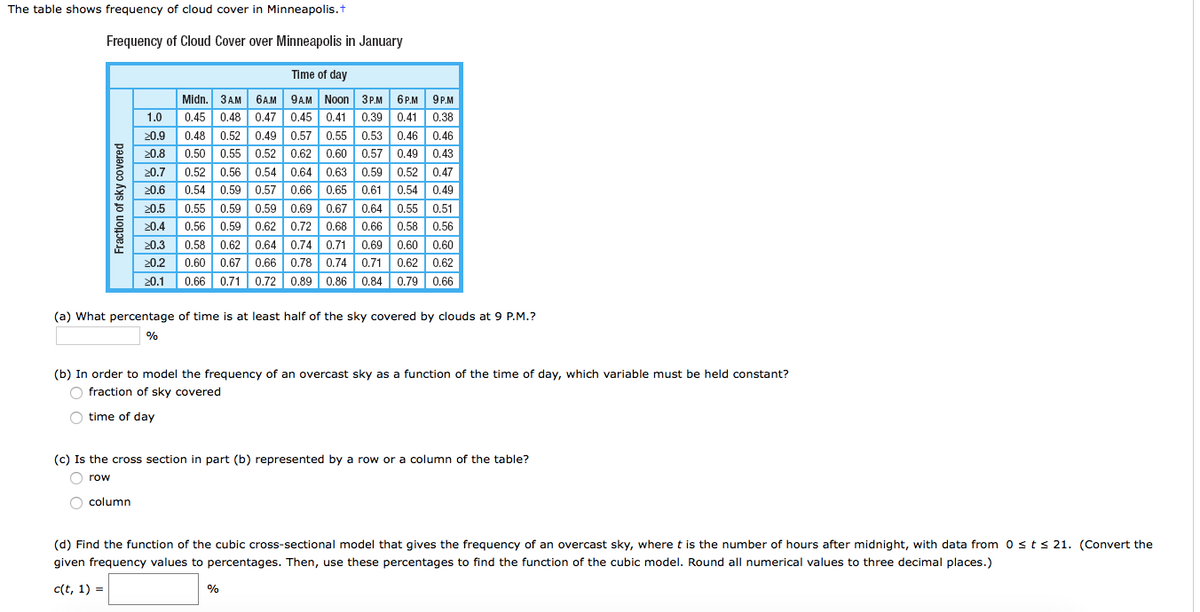Frequency of Cloud Cover over Minneapolis in January Time of day Midn. 3AM 6AM 9AM Noon 3PM 6PM 0.45 0.48 0.47 0.45 0.41 0.39 0.41 0.38 9PM 1.0 20.9 0.48 0.52 0.49 0.57 0.55 0.53 0.46 0.46 0.55 0.52 0.62 0.60 0.52 0.56 0.54 0.64 0.63 0.59 0.52 0.47 20.8 0.50 0.57 0.49 0.43 20.7 3 20.6 0.54 0.59 0.57 0.66 0.65 0.61 0.54 0.49 0.55 0.59 0.59 0.69 0.67 0.64 0.55 0.51 0.56 0.59 0.62 0.72 0.68 0.66 0.58 0.56 20.5 20.4 0.58 20.2 0.60 0.67 0.66 0.78 0.74 0.71 0.62 0.62 20.1 0.66 0.71| 0.72 0.89 0.86 0.84 0.79 0.66 | 20.3 0.62 0.64 0.74 0.71 0.69 0.60 0.60 (a) What percentage of time is at least half of the sky covered by clouds at 9 P.M.? | % (b) In order to model the frequency of an overcast sky as a function of the time of day, which variable must be held constant? O fraction of sky covered time of day (c) Is the cross section in part (b) represented by a row or a column of the table? row column Fraction of sky covered
Frequency of Cloud Cover over Minneapolis in January Time of day Midn. 3AM 6AM 9AM Noon 3PM 6PM 0.45 0.48 0.47 0.45 0.41 0.39 0.41 0.38 9PM 1.0 20.9 0.48 0.52 0.49 0.57 0.55 0.53 0.46 0.46 0.55 0.52 0.62 0.60 0.52 0.56 0.54 0.64 0.63 0.59 0.52 0.47 20.8 0.50 0.57 0.49 0.43 20.7 3 20.6 0.54 0.59 0.57 0.66 0.65 0.61 0.54 0.49 0.55 0.59 0.59 0.69 0.67 0.64 0.55 0.51 0.56 0.59 0.62 0.72 0.68 0.66 0.58 0.56 20.5 20.4 0.58 20.2 0.60 0.67 0.66 0.78 0.74 0.71 0.62 0.62 20.1 0.66 0.71| 0.72 0.89 0.86 0.84 0.79 0.66 | 20.3 0.62 0.64 0.74 0.71 0.69 0.60 0.60 (a) What percentage of time is at least half of the sky covered by clouds at 9 P.M.? | % (b) In order to model the frequency of an overcast sky as a function of the time of day, which variable must be held constant? O fraction of sky covered time of day (c) Is the cross section in part (b) represented by a row or a column of the table? row column Fraction of sky covered
Functions and Change: A Modeling Approach to College Algebra (MindTap Course List)
6th Edition
ISBN:9781337111348
Author:Bruce Crauder, Benny Evans, Alan Noell
Publisher:Bruce Crauder, Benny Evans, Alan Noell
Chapter5: A Survey Of Other Common Functions
Section5.3: Modeling Data With Power Functions
Problem 2E: Planetary Velocity The following table gives the mean velocity of planets in their orbits versus...
Related questions
Question

Transcribed Image Text:The table shows frequency of cloud cover in Minneapolis.t
Frequency of Cloud Cover over Minneapolis in January
Time of day
Midn. 3 A.M 6A.M 9AM Noon 3P.M 6P.M 9P.M
0.45 0.48 0.47 0.45 0.41 0.39 0.41 0.38
0.48 0.52 0.49 0.57 0.55
0.50 0.55 0.52 0.62 0.60 0.57 0.49 0.43
0.52 0.56 0.54 0.64 0.63 0.59 0.52 0.47
0.54 0.59 0.57 0.66 0.65
0.55 0.59 0.59 0.69 0.67 0.64 0.55 0.51
0.56 0.59 0.62 0.72 0.68 0.66 0.58 0.56
0.58 0.62 0.64 0.74 0.71
20.2 0.60 0.67 0.66 0.78 0.74 0.71 0.62 0.62
0.66 0.71 0.72 0.89 0.86 0.84 0.79 0.66
1.0
20.9
0.53 0.46 0.46
20.8
20.7
20.6
0.61 0.54 0.49
20.5
20.4
20.3
0.69 0.60 0.60
20.1
(a) What percentage of time is at least half of the sky covered by clouds at 9 P.M.?
%
(b) In order to model the frequency of an overcast sky as a function of the time of day, which variable must be held constant?
O fraction of sky covered
O time of day
(c) Is the cross section in part (b) represented by a row or a column of the table?
O row
O column
(d) Find the function of the cubic cross-sectional model that gives the frequency of an overcast sky, where t is the number of hours after midnight, with data from 0 sts 21. (Convert the
given frequency values to percentages. Then, use these percentages to find the function of the cubic model. Round all numerical values to three decimal places.)
c(t, 1) =
%
Fraction of sky covered
Expert Solution
This question has been solved!
Explore an expertly crafted, step-by-step solution for a thorough understanding of key concepts.
This is a popular solution!
Trending now
This is a popular solution!
Step by step
Solved in 2 steps with 1 images

Knowledge Booster
Learn more about
Need a deep-dive on the concept behind this application? Look no further. Learn more about this topic, advanced-math and related others by exploring similar questions and additional content below.Recommended textbooks for you

Functions and Change: A Modeling Approach to Coll…
Algebra
ISBN:
9781337111348
Author:
Bruce Crauder, Benny Evans, Alan Noell
Publisher:
Cengage Learning

Big Ideas Math A Bridge To Success Algebra 1: Stu…
Algebra
ISBN:
9781680331141
Author:
HOUGHTON MIFFLIN HARCOURT
Publisher:
Houghton Mifflin Harcourt

Algebra & Trigonometry with Analytic Geometry
Algebra
ISBN:
9781133382119
Author:
Swokowski
Publisher:
Cengage

Functions and Change: A Modeling Approach to Coll…
Algebra
ISBN:
9781337111348
Author:
Bruce Crauder, Benny Evans, Alan Noell
Publisher:
Cengage Learning

Big Ideas Math A Bridge To Success Algebra 1: Stu…
Algebra
ISBN:
9781680331141
Author:
HOUGHTON MIFFLIN HARCOURT
Publisher:
Houghton Mifflin Harcourt

Algebra & Trigonometry with Analytic Geometry
Algebra
ISBN:
9781133382119
Author:
Swokowski
Publisher:
Cengage

Glencoe Algebra 1, Student Edition, 9780079039897…
Algebra
ISBN:
9780079039897
Author:
Carter
Publisher:
McGraw Hill

Elementary Geometry For College Students, 7e
Geometry
ISBN:
9781337614085
Author:
Alexander, Daniel C.; Koeberlein, Geralyn M.
Publisher:
Cengage,